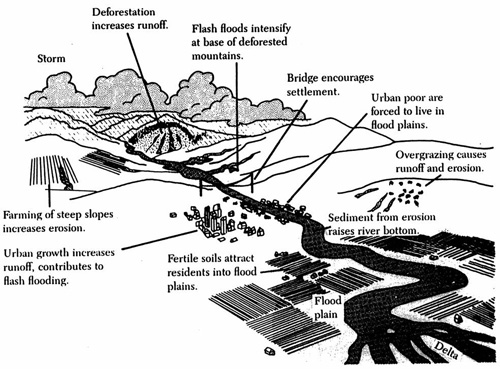Case study
Let us consider an example of the way in which a community interacts with its environment and hazards.
What happens when people move into a hilly, forested area with a medium to high annual rainfall, and they clear land for agriculture?
Before the forest is cleared, rainfall is absorbed and trapped by the live and dead vegetation, and by the accumulated humus, before it has a chance to run off to creeks and rivers. In a way, forests and many other natural ecosystems such as swamps act as sponges during heavy rain, in that they store a certain amount of water, some of which then evaporates or is slowly released over a prolonged period of time. Of course there is still the potential for flood, but it is only the very heavy rain events that will cause serious flooding.
When a forested area is cleared, the drainage characteristics are different. There is less vegetation and humus to collect and store water, and so the water runoff is greater. There is also a greater amount of erosion, and so the profile of river beds is altered by silt. So when heavy rainfall occurs, there is a greater likelihood of serious flooding. This serious flooding may lead, in turn, to further changes in the drainage system.

Figure 2.2
The evolution of natural hazards
(Ruchelman, L.I. (1988). Natural hazard mitigation and development: An exploration of the roles of the public and private sectors. In Managing disasters: Strategies and policy perspectives, Duke University Press: London , p. 61.)
Given that parts of this community will probably live on or own property on or near flood plains, and that their settlement may only have taken into account the flood characteristics that existed prior to forest clearing, there may be some problems.
So you see, when we analyse hazards we must take into account the interaction of environment, hazards and the community-and we do this by adopting a process to analyse hazards within a risk assessment.
